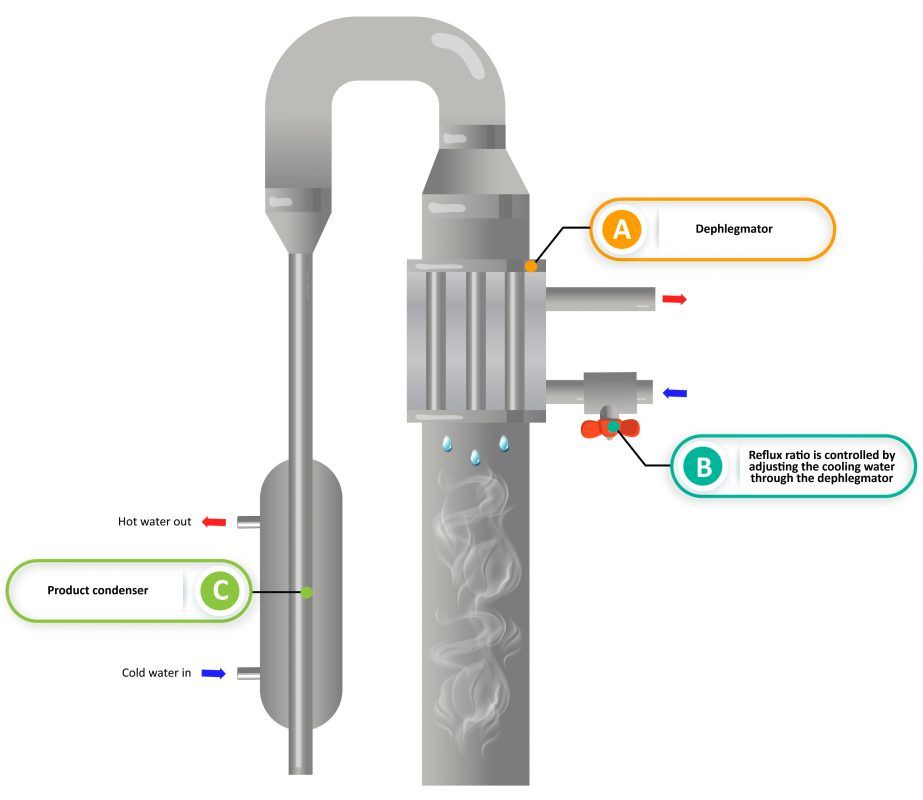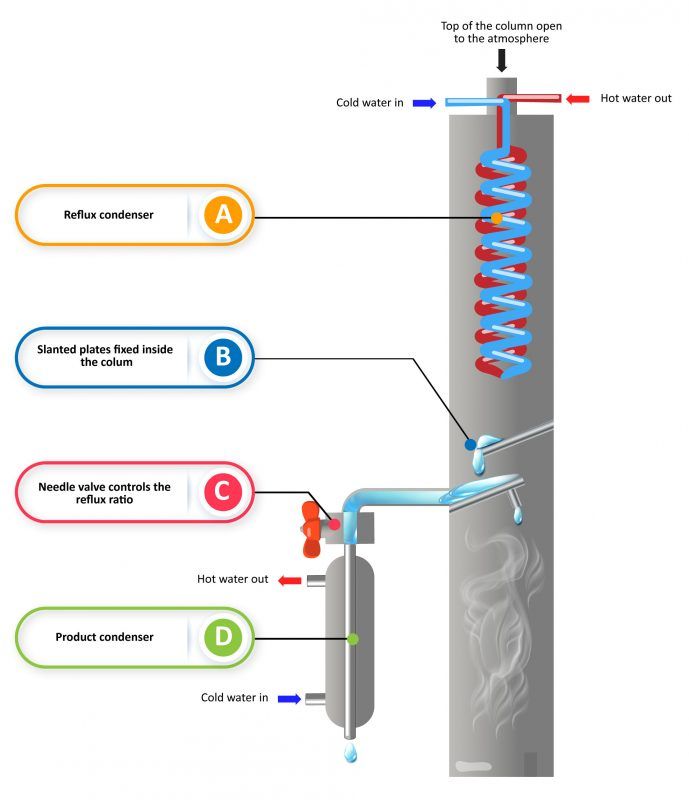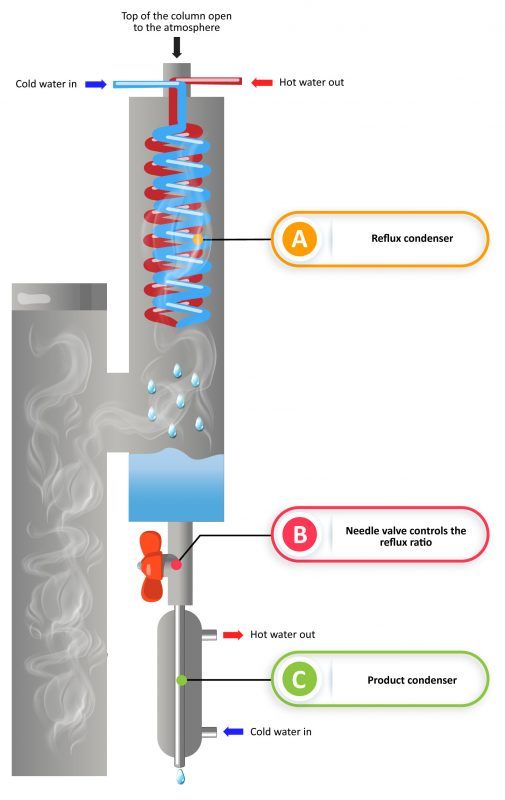Distilling Hardware
Our Complete Guide To Reflux Stills (Start Here)
Reflux stills are excellent tools for producing high ABV (proof) alcohol with exceptional purity.
A reflux still works by having a tall column containing either bubble plates or special packing material. There is also a reflux condensor or dephlegmator returning vapor back down the column which causes multiple distillations instead of just one in a pot still. The effect is a higher purity neutral product up to 95% ABV or 190 Proof.
In this post, I’ll shed light on stills you’re likely to encounter in your craft and help you choose the best one based on your expertise.
Table of Contents
What’s The Point Of A Reflux Still?
The purpose of a reflux still is to separate alcohol from impurities, like congeners, and other unwanted compounds through fractional distillation. The still is revered because it produces highly concentrated alcohol and a cleaner final product.
Reflux Still Vs. Pot Still
Because they have a shorter column and a simple design, pot stills retain more congeners. They’re mainly used to produce flavorful spirits with rich character and aroma, like whiskey and rum.
Reflux stills comprise additional components to improve the separation of alcohol from impurities. They have long columns packed with attachments, like bubble plates, that help increase the surface area. This in turn encourages reflux action and strips off impurities, increasing the purity of your spirit. Reflux stills are perfect for neutral spirits, like vodka.
| Pot Still | Reflux Still | |
|---|---|---|
| ABV: | Typically produce product at 50-80% ABV | Typically produce product at 90-95% ABV |
| Flavor | Good flavor rentention | Good for making flavorless spirits |
| Speed | Fast, easy to use | Slow, hard to use |
| Cuts | Difficult. Large amount of smearing between fractions | Good flavor retention |
| Best For | Good for making whiskey, rum, brandy, tequila and gin | Good for making vodka and neutral spriits. |
How Does A Reflux Still Work?
Reflux ratio
A higher reflux ratio means more liquid is returned, resulting in a higher degree of separation and increased purity. You can control the reflux ratio by adjusting the temperature to strike a balance between purity and speed.
Bubble plates
These plates are stacked within the column, and each one contains a series of holes or slots. As the vapor rises through the column, it encounters these plates. The liquid flowing down the column creates a reflux flow, and when the vapor passes through the holes on each plate, it bubbles up, creating more surface area for contact with the liquid.
Column height
A taller column can accommodate more plates, which allows for better separation of impurities. The vapor travels up the column, and as it condenses on the plates or packing material, it collects purified alcohol and drops back down.
The Different Reflux Still Designs
Vapor management
The vapor management (VM) still splits the vapor into two streams and condenses each stream separately before generating reflux. It uses a valve to control the reflux ratio, making it easier to maintain a constant ratio during the heart’s distillation phase. Another unique feature of the VM is the valve settings in the column remain constant across different charges or variations in heat input. This predictability and consistency make it a favorable choice for distillers.


Cooling management
The cooling management still entails controlling the flow of the cooling water. The process involves condensing a portion of the vapor and redirecting it down the column as reflux. You can reduce the water flow, so the reflux ratio decreases while the output increases or increase the cooling water to increase the reflux ratio. The cooling management design comes in various forms, but the most common design features cooling lines that run through the column on their way to the condenser.


Liquid management
Liquid management (LM) stills allow you to control the amount of liquid exiting the condenser through a needle valve. They condense vapors as they move through the column between two copper plates placed at an angle. Vapor reaches the condenser at the top of the column and condenses. The liquid then drops onto the plates or down the column. When the liquid has settled on the plates, you can open the valve to collect the desired liquid. Or you can keep it closed to allow the reflux action to proceed until you collect a purer spirit.


CCVM
Condenser-controlled vapor management (CCVM) stills allow you to control the vapor of your distillate through the use of a reflux condenser. It incorporates a compact fractionating column with various attachments, like bubble plates or packed sections. It works similarly to vapor management still, but instead of opening and closing a valve, you change the position of a copper coil within the column. Depending on how you’ve positioned the coil, the steam can either move into the lyne arm or to the condenser at the top of the column. If you move the attachment to the center, half of the vapors travel into the lyne arm and into the product condenser, while the rest move to the top, condense, and fall down the column.

How To Make A Reflux Still
To make a reflux still, you’ll need:
- A boiler
- Column
- Condenser
- Reflux management system
- Fittings and connectors
You can construct the column using copper or stainless steel, and the condenser can be a dephlegmator or shotgun. For an in-depth illustrated guide, check out Designing & Building Automatic Stills by Riku Richardson.
How To Clean A Reflux Still
Here’s how to clean your reflux still.
- Disassemble the still.
- Remove any residue or impurities, and sanitize the components. Copper is corrosive so you need to clean copper components with a mild detergent or commercial copper cleaning agents. If you’re using stainless steel, you can get away with using a detergent of your choice.
- Rinse all the parts thoroughly.
- Reassemble and store the still.
Read More: For an in-depth guide, read our tutorial on cleaning your still here
How To Operate A Reflux Still
- Pack your column with copper scrubbings or raschig rings.
- Turn on the heat source.
- Adjust the reflux control valve or cooling system to achieve the desired reflux ratio.
- Collect the distillate as it flows out of the condenser.
- Discard the foreshots.
- Collect the hearts.
- Stop collecting when the hearts transition to tails.
The Best Reflux Still To Buy
For beginners: Ai-C Dibosh
The still features separately built-in distillation and cooling towers, which increase the alcohol content and produce a purer liquor. It’s equipped with red copper coils, which are excellent thermal conductors. The still supports multiple heating methods, providing flexibility to the novice distiller. You can also use the boiler as a fermentation tank and when you’re ready to distill, you can use various heat sources–coal gas, natural gas, and firewood.
On a budget: Vevor Still with rectifying tower
The Vevor still features a 5.3-gallon stainless steel fermenter with a capacity of 20 liters, allowing you to distill a significant amount of alcohol at one time. One key advantage of this model is its excellent impurity filtration system. It comes with ceramic balls to effectively filter out impurities in the wash. The inclusion of a water-circulating pump hastens water flow for effective condensation, while the dual thermometer offers optimum temperature control.
For the intermediate: The T500 Turbo Still
One of the best features of the T500 is that it allows you to collect 95% of the alcohol present in the wash, resulting in an alcohol purity of 93%. It boasts a durable stainless steel construction and its design includes a convenient faucet adaptor for easy water flow adjustment. The still also includes safety features such as a boil dry reset and a thermal cut-out fuse.
For the advanced distiller: Yuewo Column Still
This beautifully designed still has several features for experienced individuals in distilling. It has a four-layer distillation column, which helps in the removal of methanol and fusel oil, ensuring a high-quality end product. The still includes a copper bubble plate made of 99.95% pure copper that can eliminate sulfide and odors. It features a customized basket made of high-quality 304 stainless steel, allowing you to distill both solids and liquids. Yuewo also offers three levels of power adjustment: standard distillation, slow distillation, or constant temperature operation, helping you achieve repeated precise results.
4 Tips When Running Your Reflux Still
- Let the column equalize
- Avoid flooding the column
- Use a proofing parrot
- All stills are different, so learn how yours runs best
1. Let the column equalize
Allow the column to reach a stable operating temperature. This ensures the system has achieved equilibrium so it can separate volatile compounds and purify the wash effectively.
2. Avoid flooding the column
Flooding occurs when too much liquid enters the column, preventing proper vapor flow. Here’s what you can do to avoid flooding:
- Experiment with your still and adjust the temperature, this allows you to control the pressure within the still.
- Decrease the feed rate and reflux ratio.
- Closely monitor and adjust the temperature accordingly to reduce the flow rate.
3. Use a proofing parrot
Using a proofing parrot allows you to monitor the ABV of the spirit in real-time to make precise cuts. You can track any adjustments you may need to make when the distillation process is complete.
4. All stills are different, so learn how yours runs best
It’s essential to become familiar with your still through practice and experimentation. Take notes, make adjustments, and learn from each run until you achieve the desired results.
Final Thoughts
Liquid management, vapor management, and condenser-controlled vapor management are a few of the best reflux stills for home-distillers. They are much easier to operate, making them beginner-friendly. They’re also designed to effectively remove volatile compounds while delivering quality spirits.
Frequently Asked Questions
Q. What does a reflux do on a still?
Reflux on a still helps separate alcohol from impurities. It occurs when the vapor rising in the column encounters liquid dropping into the column. This continuation enhances the removal of unwanted compounds, resulting in a higher-proof and cleaner distillate.
Q. Is a reflux still better?
Reflux stills are fantastic if you want to produce pure and high-proof alcohol. They effectively remove impurities and create a clean, neutral spirit, like vodka or gin. If you’re looking to produce spirits with more character and flavor–whiskeys, rum– opt for a pot still.
Q. Can you make moonshine in a reflux still?
You can use a reflux still to make moonshine, it will help you achieve a clean, high-ABV spirit.
Q. Can you use a reflux still to make whiskey?
It’s not recommended to use a reflux still to make whiskey. The spirit derives much of its flavor and complexity from the congeners in the wash, which are often stripped away during reflux distillation, so a pot still is the better option.
Q. Can you use a reflux still to make gin?
You can use a reflux still to make gin. Gin uses neutral spirit as a base alcohol, which can be produced using a reflux still.
Q. Can you use a reflux still to make vodka?
Reflux stills are commonly used to produce vodka because they strip away impurities, resulting in a smooth and pure spirit.








